Extra Questions for Class 9 Science Chapter 4 Structure of the Atom
Extra questions for Class 9 Science Chapter 4 Structure of the Atom with answers is given below. Our subject expert prepared these solutions as per the latest NCERT textbook. These questions will be helpful to revise the all topics and concepts. CBSE Class 9 extra questions are the most simple and conceptual questions that are prepared by subject experts for the students to study well for the final exams. By solving these extra questions, students can be very efficient in their exam preparations.
Structure of the Atom Class 9 Science Extra Questions and Answers
Very Short Answer Questions
1: Draw the atomic structure of hydrogen atom.
Answer:
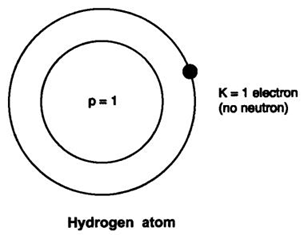
2: Why are some elements chemically inert?
Answer: Because their outermost shell is completely filled.
3: Why is atom electrically neutral?
Answer: It has same number of protons and electrons, (positive charge = negative charge).
4: What is the charge and mass of a-particles?
Answer: Charge is + 2
Mass is 4 a.m.u.
5: What are valence electrons?
Answer: Electrons present in the outermost shell of an atom are called valence electrons.
6: An atom has atomic number 12, what is its valency and name the element?
Answer: Atomic number = 12
∴ Protons = Electrons = 12 Electrons Configuration = K L M -2 8 2
∴ Valency = 2
Element is magnesium.
7: Find the number of neutrons in 2713X.
Answer: Mass number = 27
∴ p + n = 27 p = 13, (Atomic No. = Number of protons)
∴ 13 + n = 27
∴ n = 14
∴ Neutron =14
8: Where is the mass of atom is concentrated?
Answer: Mass of an atom is concentrated in nucleus.
9: Name two elements with same number of protons and neutrons?
Answer: Carbon (Protons = Neutrons = 6)
Oxygen (Protons = Neutrons = 8)
10: Draw the atomic structure of sodium atom.
Answer:
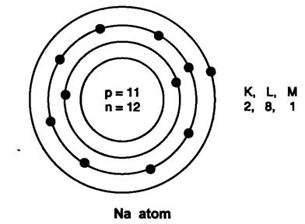
11: Name the isotope used for treatment of cancer.
Answer: Isotope of cobalt.12: AZX What does this symbol represent?
Answer: X → Symbol of element
A → Mass number
Z → Atomic number
13: Can the value of ‘Z’ be same for two different atoms?
Answer: No, (Z = atomic number), two different atoms cannot have same atomic number.
14: Can the value of A’ be same for two different atom?
Answer: Yes, it can be e.g. Ca and Ar has A-40 (i.e., mass number).
Short Answer Type Questions
1: Name the scientist who discovered protons and neutrons in an atoms.
Answer: Protons were discovered by E. Goldstein in 1866 and neutrons were discovered by J, Chadwick in 1932.
2: What is the contribution of Bohr and Bury together in the structure of atom’s explanation?
Answer: Both Bohr and Bury gave the distribution of electrons into different atoms by giving the formula 2n2, where n = shell number.
3: Draw the atomic structure of (i) an atom with same number of sub-atomic particles, (ii) an atom with same number of electrons in L and M shell.
Answer: (i) An atom with same number of sub-atomic particles is He
No. of protons = 2
No. of electrons = 2
No. of neutrons = 2
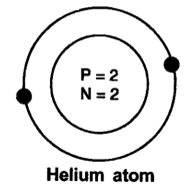
(ii) An atom with L and M shell filled → K L M- 2 8 8
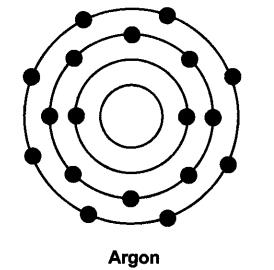
4: What is an octate? Why would atoms want to complete their octate?
Answer: When the outermost shell of an atom i.e., L, M or N are completely filled with 8 electrons in the shell, it is said an octate. Atoms would want to complete their octate because they want to become stable.
5: Find the valency of 147N and 3517Cl.
Answer: The atomic number of nitrogen = 7, No. of protons = 7, No. of electrons = 7
Electronic configuration = K L M = 2 5 –
Valency = 3
Because either it will gain three electrons or share 3 electrons to complete its octate.
The atomic number of chlorine = 17, p = 17, e=17
Electronic configuration = K L M= 2 8 7
Valency = 1
Because it will gain 1 electron to complete its octate.
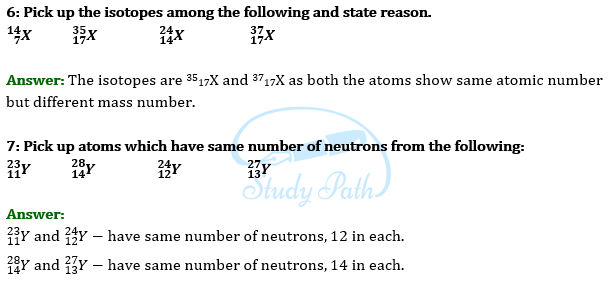
8: What are nucleons? What is the name given to those atoms which have same number of nucleons in it?
Answer: Protons and neutrons present in the nucleus are called nucleons Isobaric elements have same number of nucleons in it.
| Element | Protons | Neutrons | (Protons + Neutrons) |
| Argon | 18 | 22 | 40 |
| Calcium | 20 | 20 | 40 |
| Potassium | 19 | 21 | 40 |
9: Give the difference between three sub-atomic particles.
Answer: Three sub-atomic particles are electron, proton and neutron

10. Give the names of three atomic species of hydrogen.
Answer: Three atomic species of hydrogen are:
| Name | Protium | Deuterium | Tritium |
| Symbol | 11H | 21H | 31H |
| Protons | 1 | 1 | 1 |
| Atomic no. | 1 | 1 | 1 |
| Neutrons | 0 | 1 | 2 |
11: Atomic Mass exists as whole number, why do we write the atomic mass of chlorine as 35.5 u.
Answer: Chlorine has two isotopes and the mass of an atom is taken as the average mass of all the naturally occurring atoms of that element.
This is obtained by knowing the percentage of each isotopic from and then the average mass is calculated Cl = 35 – 75% and Cl = 37 – 25% = 35.5 u
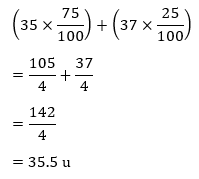
12: Give difference between isotopes, and isobars.
Answer:
| Isotopes | Isobars |
| Are atoms of same element. | Are atoms of different element |
| Have same atomic number | Have different atomic number |
| Have different mass number | Have same mass number |
| Number of protons and electrons are same in these atoms. | Number of protons and electrons are not same in these atoms. |
13: Number of protons and electrons are same in an atom. Then why is it wrong to say that atomic number of an atom is equal to its number of electrons.
Answer: Atomic number ≠ Number of electrons, although number of protons = number of electrons because the electron’s number can change in an atom by loss, or gain of it. But the proton’s number remain constant (as it does not take part in loss or gain).
14: An atom is electrically neutral, on loss or gain of electrons why does it become charged?
Answer: An atom is electrically neutral because of same number of protons and electrons. But it becomes charged, to become stable atom, loses or gains electrons. Hence,
Number of protons ≠ Number of electrons
If it loses electrons p > e; hence +ve charge is obtained.
If it gains electrons e > p; hence -ve charge is obtained.
15: What is valency? Explain different types of valencies.
Answer: The combining capacity of an atom is called its valency. There are 2 types of valencies.
| Covalency | Electrovalency |
| When an atom share electrons have combining capacity. | When an atom loses or gains electrons |
Some atoms also show zero valency when there outermost shell is completely filled.
16: With the help of an activity in daily life, how can you prove that atoms are divisible.
Answer: Activity
- Take a scale, rub it on hair, try to attract a small bit of paper.
- Now divide the bit of paper further into smaller pieces
- Again bring the charged scale near to this pieces of papers.
- You will observe that the bits of paper still get attracted.
Conclusion: This activity shows that atom contains charges and these charges are opposite in nature which shows the attraction. Hence here scale and paper both are oppositely charged and hence attract each other. Also, every atom has at least one sub-atomic particle.

17: In the structure of an atom why are protons present in the centre and are not pulled outside by the electrons as both are oppositely charged with same unit of charge?
Answer: Protons are heavy with mass 1 unit and hence are concentrated in the centre
of the atom. The mass of electrons is negligible i.e.1/1800 times less than that of protons. Hence are not able to attract the protons and pull them out of the nucleus, although their charge is of same value.
18: According to you, among the structure of atom studied which model is correct and why?
Answer: Bohr’s model of an atom is the best model and is correct because it gives the explanation of nucleons (protons and neutrons) in the centre and how electrons revolve around the nucleons in their discrete, special orbits, so electrons don’t loose/radiate energy and remain bonded in their shell.
Long Answer Type Questions
1. Give an activity to understand the implications of Rutherford’s a scattering experiment by a gold foil.
Answer: To understand the implications of Rutherford’s a-particle scattering experiment:
Activity: Let a child stand in front of a wall with his eyes closed. Let him throw stones at the wall from a distance. He will hear sound for each strike of stone on the wall. This is like a nucleus of the atom. But if a blind-folded child has to throw stones at a barbed-wire fence, most of the stones would not hit the fencing and no sound would be heard.
This is because there are lots of gap in the fence which allows the stone to pass through them. This is like empty space in an atom through which a-particles will pass through. Based on the above activity and similar reasoning Rutherford concluded the a-particle scattering experiment as:
(1) Most of the space inside the atom is empty as a-particles passed through the foil.
(2) Very few particles deflected from their path, this show that positive charge occupies less space.
(3) A very small fraction of a-particles are deflected by 180°, this shows that all the positive charge and mass of the gold atom were concentrated in a very small volume within the atom.
2: What are isotopes? State its characteristics, give uses of isotopes?
Answer: Atoms of same element with same atomic number but different mass number are isotopes.
Characteristics:
(1) Physical properties of the isotopes are different e.g. mass, density.
(2) Chemical properties of the isotopes are same due to same number of electrons.
Uses:
(1) Uranium isotope is used as a fuel in nuclear reactor (U-235).
(2) Cobalt isotope is used for treatment of cancer (Co-60).
(3) Iodine isotope is used in the treatment of goitre.
3: Explain Rutherford’s α-particle scattering experiment and give its observation and conclusion drawn.
Answer: Rutherford’s α-particle scattering experiment:
Fast moving α-particles were made to fall on a thin gold foil. Particles have + 2 charge and 4u mass, and considerable amount of energy.
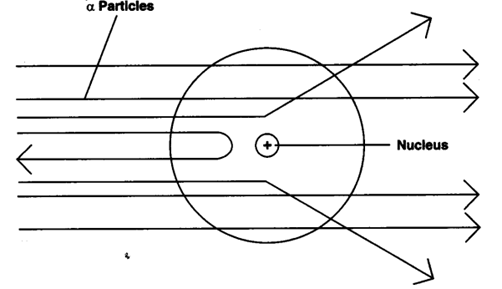
Observations:
(1) Most of the α-particles passed straight through the foil.
(2) Some of the α-particles were deflected by small angles by the foil.
(3) One out of every 12000 particles rebounded.
Conclusion from observation:
(1) Most of the space inside the foil is empty.
(2) Positive charge of atom occupies very less space.
(3) Mass of the atom is concentrated in the centre with all positive charge concentrated in small volume within the atom.
4: Establish the relationship between atomic number, mass number, isotopes, isobars and valency of an atom.
Answer: Atomic number — Gives the number of protons (Z)
Mass number — Gives the number of protons and neutrons (A)
Isotopes — When atoms of same element have same number of protons (Z) but different number of a neutrons (s) such atoms are called isotopes.
Isobars — When atom of different element have same mass number (A) but different atomic number (Z) such atoms are called isobars.
Valency — It is the combining capacity of an atom.
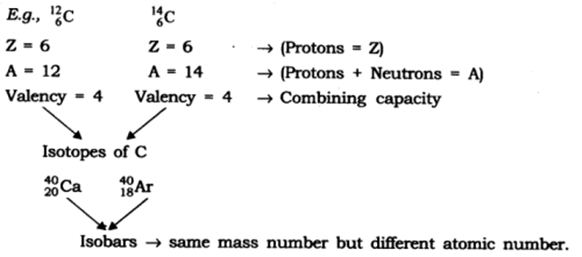
Value Based Questions
1: Aryan could not solve the following question in the group; his group mate explained him and solved his difficulty. The question was as follows:
What information do you get from the given figure about the atomic number, mass number and valency of the given atom X’.
(a) What is the answer for-the above question?
(b) Name the element X’.
(c) What value of Aryan’s friend is reflected in this behaviour?
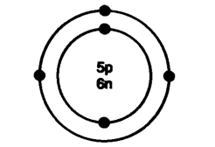
Answer: (a) The atomic number is 5.
The mass number is 11.
The valency is 3.
(b) The element X’ is boron.
(c) Aryan’s friend showed the value of helping and caring nature.